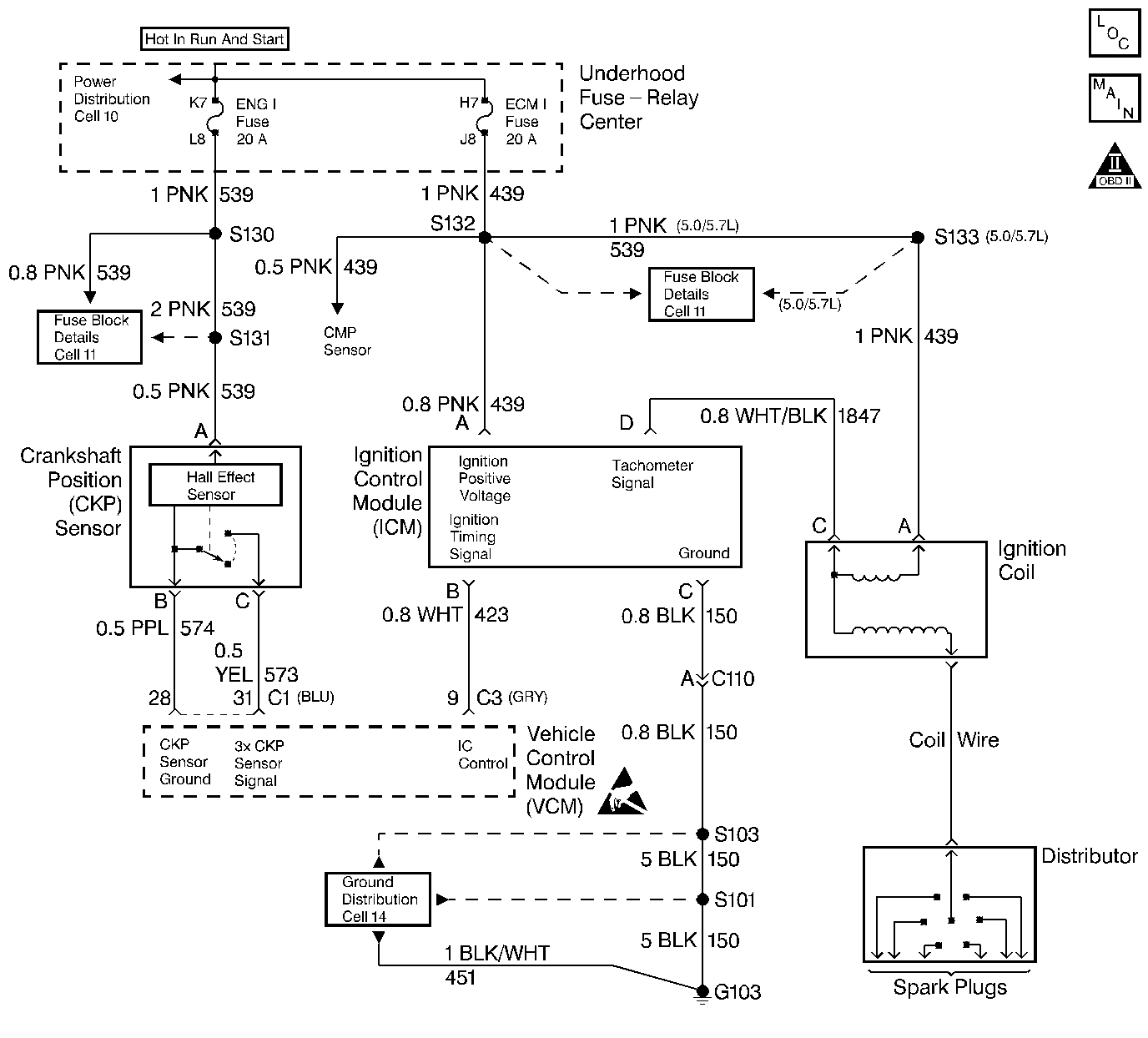
Circuit Description
The enhanced ignition system uses the crank sensor in order to provide the timing input to the VCM. The VCM uses this reference pulse in order to determine the individual ignition spark timing for each cylinder.
Once the VCM calculates the ignition timing, the ignition coil module on the IC circuit receives the timing signal. Each timing pulse received by the ignition coil module on the IC circuit triggers the coil module in order to operate the ignition coil. The secondary ignition voltage is induced, and then the secondary ignition voltage is sent to the distributor for distribution to each spark plug. This DTC is a type A DTC.
The IC signal voltage ranges from about 0.5 volt to 4.5 volts.
Conditions for Setting the DTC
The voltage on the ignition control circuit exceeds 4.9 volts, and the engine speed is less than 250 RPM.
Action Taken When The DTC Sets
| • | The VCM turns the MIL ON when this DTC is reported and one failure has occurred. |
| • | The VCM records the operating conditions at the time the Diagnostic Fails. Freeze Frame and Failure Records store this information. |
Conditions for Clearing the MIL/DTC
The VCM turns OFF the MIL after 3 consecutive driving trips without a fault condition present. A history DTC will clear if no fault conditions have been detected for 40 warm-up cycles (the coolant temperature has risen 22°C (40°F) from the start-up coolant temperature and the engine coolant temperature exceeds 71°C (160°F) during that same ignition cycle) or the scan tool clearing feature has been used.
Diagnostic Aids
A poor connection, a rubbed through wire in the insulation, or a wire broken inside the insulation will cause an intermittent.
Check for the following conditions:
| • | Poor connection |
| • | Damaged harness: Inspect the VCM harness connectors for the following conditions: |
| - | Backed out terminal C3 pin 9 |
| - | Improper mating |
| - | Broken locks |
| - | Improperly formed or damaged terminals |
| - | A poor terminal to wire connection and |
| - | Damage to the harness. |
| • | Intermittent test - If the connections and the harness check OK, monitor a digital voltmeter connected between VCM connector C3 pin 9 and C4 pin 18 while moving related connectors and wiring harness. If the failure is induced, the voltage reading will change. This may help to isolate the location of the malfunction. |
Test Description
The numbers below refer to the step numbers in the diagnostic table.
-
This determines if the DTC is an intermittent.
-
This check determines if the IC signal from the VCM is available at the ignition coil driver.
-
The remaining tests begin to check that the coil driver circuitry is OK.
Step | Action | Value(s) | Yes | No |
|---|---|---|---|---|
1 |
Important: Before clearing DTCs, use the scan tool in order to record the freeze frame and the failure records for reference because the Clear Info function will lose the data. Was the Powertrain On-Board Diagnostic (OBD) System Check performed? | -- | ||
Does DTC P1351 set? | -- | Go to Diagnostic Aids | ||
Is the voltage reading within the specified value? | 1-4 V | |||
Is the resistance less than the specified value? | 10 ohms | |||
5 | Repair the open IC circuit between the VCM and the ignition coil module. Refer to Wiring Repairs in Engine Electrical. Is the action complete? | -- | -- | |
6 | Check for a faulty VCM connection. Was a problem found? | -- | ||
7 | Repair the faulty VCM connection. Refer to Wiring Repairs in Engine Electrical. Is the action complete? | -- | -- | |
8 | Replace the VCM. Important: If the VCM is faulty, reprogram the VCM. Refer to VCM Replacement/Programming (With KS Calibration PROM) . Is the replacement complete? | -- | -- | |
9 |
Is the test lamp on? | -- | ||
10 | Repair the open ignition coil module ground circuit. Refer to Wiring Repairs in Engine Electrical. Is the repair complete? | -- | -- | |
11 |
Is the test lamp on both terminals? | -- | ||
12 | Repair the faulty ignition coil module feed circuit. Refer to Wiring Repairs in Engine Electrical. Is the repair complete? | -- | -- | |
13 | Check for a faulty ignition coil module connection. Was a problem found? | -- | ||
14 | Replace the ignition coil module. Refer to Ignition Coil Module. Is the action complete? | -- | -- | |
15 | Repair the ignition coil module connection. Refer to Wiring Repairs in Engine Electrical. Is the action complete? | -- | -- | |
16 |
Does the scan tool indicate that this diagnostic ran and passed? | -- | ||
17 | Using the scan tool, select the Capture Info and the Review Info. Are any DTCs displayed that have not been diagnosed? | -- | Go to The Applicable DTC Table | System OK |
